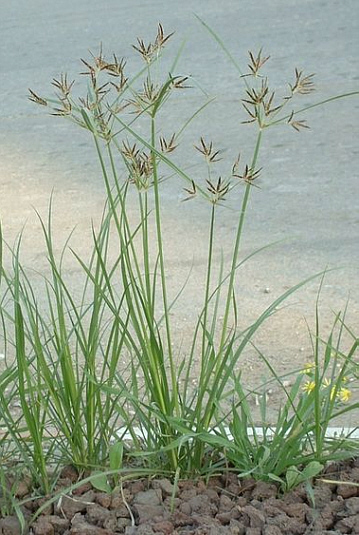

Zitierweise / cite as:
Carakasaṃhitā: Ausgewählte Texte aus der Carakasaṃhitā / übersetzt und erläutert von Alois Payer <1944 - >. -- Anhang A: Pflanzenbeschreibungen. -- Cyperus rotundus L. -- Fassung vom 2007-06-27. -- URL: http://www.payer.de/ayurveda/pflanzen/cyperus_rotundus.htm
Erstmals publiziert: 2007-06-27
Überarbeitungen:
Anlass: Lehrveranstaltung SS 2007
©opyright: Dieser Text steht der Allgemeinheit zur Verfügung. Eine Verwertung in Publikationen, die über übliche Zitate hinausgeht, bedarf der ausdrücklichen Genehmigung des Verfassers
Dieser Text ist Teil der Abteilung Sanskrit von Tüpfli's Global Village Library
WARNUNG: dies ist der Versuch einer
Übersetzung und Interpretation eines altindischen Textes. Es ist keine
medizinische Anleitung. Vor dem Gebrauch aller hier genannten Heilmittel wird
darum ausdrücklich gewarnt. Nur ein erfahrener, gut ausgebildeter ayurvedischer
Arzt kann Verschreibungen und Behandlungen machen!
Falls Sie die diakritischen Zeichen nicht dargestellt bekommen, installieren Sie eine Schrift mit Diakritika wie z.B. Tahoma.
Verwendete und zitierte Werke siehe: http://www.payer.de/ayurveda/caraka0001.htm

Abb.: Cyperus rotundus
L. — Knolliges
Zypergras
[Bildquelle: Wikipedia]
Drury:
"Cyperus hexastachyus (Rottl.) Do.
- Koray, Tam.
- Shaka-toonga, Tel.
- Kora, Mal.
- Moothoo, Beng.
Description.—Culms erect, 1-2 feet, triangular with rounded angles; leaves radical, sheathing, shorter than the culms ; root tuberous, tubers irregular, size of filberts, rusty-coloured ; umbels terminal, compound; involucre 3-leaved, unequal; spikes linear, sub-sessile. Fl. June—Aug.—Roxb. Fl. Ind. ed. Car. i. 201.—Wight Contrib. p. 81—C. rotundus, Linn.------Peninsula. Bengal
Medical Uses.—The tubers are sold in the bazaars, and used by perfumers on account of their fragrance In medicine they are used as tonic and stimulant, and have been employed in the treatment of cholera. In the fresh state, given in infusion as a demulcent in fevers, and also used in cases of dysentery and diarrhoea. It is perhaps the most common species in India of this extensive genus. It is found chiefly in sandy soils, but will grow almost anywhere. Hogs are very fond of the roots, and cattle eat the greens. It becomes a troublesome weed in the gardens, being difficult to extirpate. —(Roxb. Ainslie.) The roots are sweet, and slightly aromatic; the taste is bitter, resinous, and balsamic. Stimulant, diaphoretic, and diuretic properties are assigned them; and they are further described as astringent and vermifuge.—(Bengal Disp. p. 627. Pharm. of India.) The species C. pertenuis partakes of the same aromatic properties, and is also considered diaphoretic. Its delicate form, small and compound umbels, short slender leaves, readily distinguish this from the other Indian species. The roots, as well as being medicinal, are used for perfuming the hair.—Roxb."
[Quelle: Drury, Heber <1819 - 1872>: The useful plants of India : with notices of their chief value in commerce, medicine, and the arts. -- 2d ed. with additions and corrections. London : Allen, 1873. -- xvi, 512 p. ; 22 cm. -- s.v.]
Dutt:
"CYPERUS ROTUNDUS, Linn. Sans. Mustaka. Vern. Muthā, Beng. Mothā, Hind.
CYPERUS PERTENUIS, Roxb.
Sans. Nāgaramustaka, Vern. Nāgamtuthā, Beng. Hind.
The tubers of these two species of Cyperus are much used in Hindu medicine. Cyperus rotundus is the most common variety and is used internally. Its tubers are about the size of a pigeon's egg and of a dark brown colour externally ; internally white and fragrant. Those growing in moist soil are preferred for use. The root of Cyperus pertenuis is somewhat tuberous with many dark coloured villous fibres. It grows in low wet places and is chiefly used in the preparation of medicated oils. The properties of both are said to be identical. They are considered diaphoretic, astringent, stomachic and useful in fever, diarrhoea and dyspepsia. The tubers of Cyperus rotundus are extensively used as an aromatic adjunct to numerous compound medicines.
Shadanga pāniya. Take of the tubers of Cyperus rotundus, red sandal wood, root of Andropogon muricatus, ( usira ), Oldenlandia herbacea, (parpata), Pavonia odorata (bālā) and dry ginger each one drachm, water two seers ; boil down to one seer. This decoction is given as a drink for appeasing thirst and relieving heat of body in fever. It may be taken ad libitum."
[Quelle: Dutt, Uday Chand: The materia medica of the Hindus / Uday Chand Dutt. With a glossary of Indian plants by George King. -- 2. ed. with additions and alterations / by Binod Lall Sen & Ashutosh Sen. -- Calcutta, 1900. - XVIII, 356 S. -- S. 264f.]